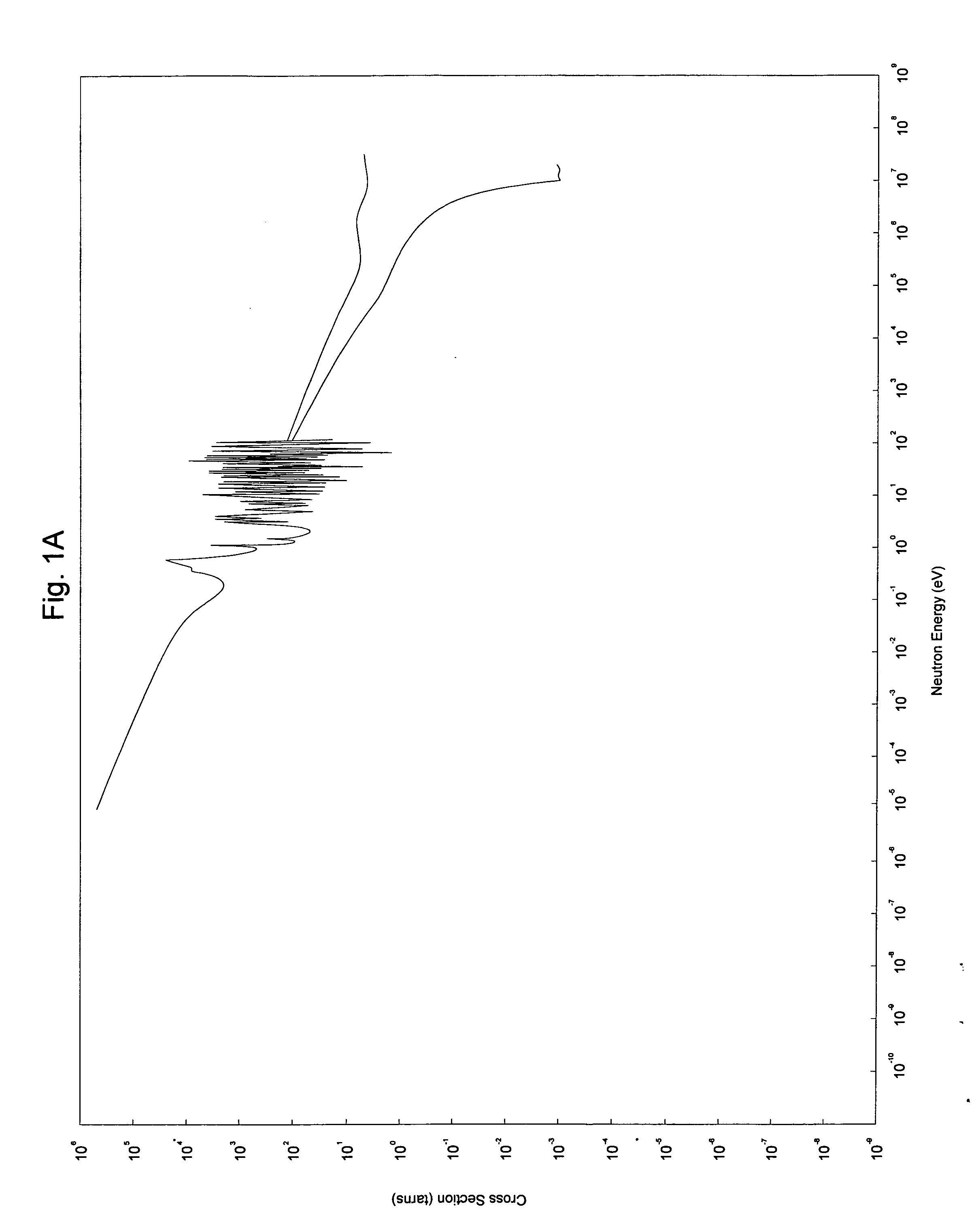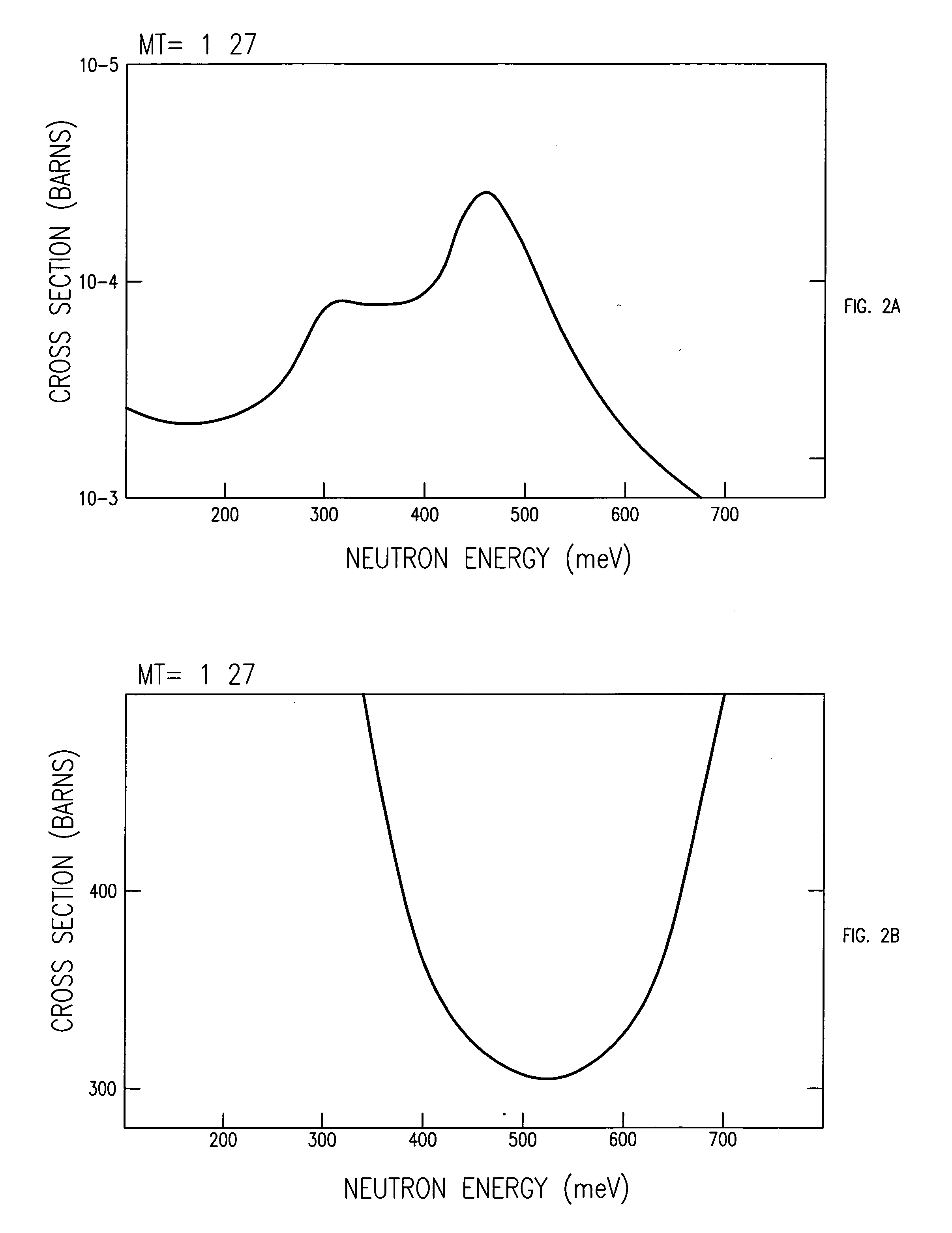Method of producing europium-152 and uses therefor
- Summary
- Abstract
- Description
- Claims
- Application Information
AI Technical Summary
Benefits of technology
Problems solved by technology
Method used
Image
Examples
example 1
Competing Resonance Absorption Peaks of 151Eu(n,γ)152Eu and 152Eu(n,γ)153Eu
[0051]Europium-151, the target nuclide from which to produce europium-152, is remarkable, if not unique, because of its extraordinarily large activation cross-section for the reaction, 151Eu(n,γ)152Eu, in the epithermal neutron region (FIG. 1A). That cross-section, as a function of neutron energy, σact(En), contains multiple resonance absorption peaks in the neutron energy range from about 0.125 eV to about 100 eV. Unfortunately, as the irradiation progresses, there exist strong competing resonances in the “burn-up” reaction, 152Eu(n,γ)153Eu (FIG. 1B), which are significant over the neutron spectrum for ˜0.025 eV ≦En≦0.11 eV and 0.9≦En≦˜9.0 eV. The existence of these very large, conflicting, resonance absorption peaks, one for the creation of the desired 152Eu and the other for its burn-up to form 153Eu, generates a situation in straightforward reactor physics which would seem to place an upper limit on the a...
example 2
Computer Simulations
[0052]The first step in the achievement of flux optimisation or spectrum tailoring following analytical calculations is the computer simulation of the irradiation. Such simulations have historically accounted for so many deterministic and statistical second- and third-order effects that one has been able, with a high level of confidence, to expect the outcome of an actual production run to approach the computed predictions very closely indeed. The cross section data for both for europium-151 and europium-152 was obtained from the Japanese Evaluated Nuclear Data Library (JENDL) (6-7).
example 3
Simulated Production of Europium-152 Using Spectrum Tailoring
[0053]An inspection of FIGS. 2A-2B reveals that in the epithermal region, En≈0.46 eV, the activation cross section, σact(En), for the reaction, 151Eu (n,γ)152Eu, has a resonance peak roughly equal to 2.6×104 barns and that no such peak exists in the cross section for the competing reaction, where σabs≈320 barns for 152Eu(n,γ)153Eu. It is that neutron energy that was selected for centering a tailored spectrum.
[0054]Simulations, shown in Table I for the High Flux Isotope Reactor [HFIR] and the Fast Flux Test Reactor [FFTF] of the US Department of Energy, selected to tailor the neutron spectrum and centre it about the resonance peak at En=0.46 eV have shown a maximum total activity per gram of enriched 151EuN slightly greater than 5.8Tbq μg−1 (˜156 Ci μg−1). Table I includes the total activity and specific activity in the simulated production of 152Eu by 151Eu(n,γ)152Eu with spectrum tailoring where 0.1≦En≦0.8 eV. The target ...
PUM
 Login to View More
Login to View More Abstract
Description
Claims
Application Information
 Login to View More
Login to View More - R&D
- Intellectual Property
- Life Sciences
- Materials
- Tech Scout
- Unparalleled Data Quality
- Higher Quality Content
- 60% Fewer Hallucinations
Browse by: Latest US Patents, China's latest patents, Technical Efficacy Thesaurus, Application Domain, Technology Topic, Popular Technical Reports.
© 2025 PatSnap. All rights reserved.Legal|Privacy policy|Modern Slavery Act Transparency Statement|Sitemap|About US| Contact US: help@patsnap.com



